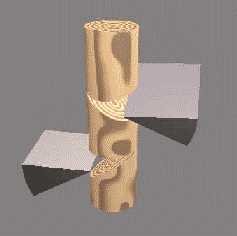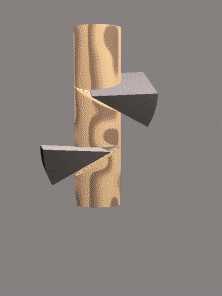| |
To do a diagonal fall, cut out a
wedge shaped piece of wood and leave a hinge-like piece
about 10% of the tree's thickness. This will help determine the initial direction
of tree fall. The tree will move down and to one side. Once the tree starts to move,
the hinge works the same as a door hinge, the momentum carries the tree in the direction
determined by the hinge. If the thickness of the hinge is not great enough, the material will begin to tear or rip.
The hinge is the source of the lateral, or horizontal vector. There will be less energy directed to the horizontal movement
if tearing occurs.
This makes leaning trees more controllable in terms of
the range of felled positions. With ordinary cuts, the tree falls same direction
each time, forward. If the tree does not favor any other
direction by leaning, that is. If the tree leans, the task is less
predictable. Visualize a small river or creek with a
Sycamore leaning over the water at about 45 degrees, half
way between up and down. You want the tree to fall
on the bank. That is not going to happen with a
traditional cut. Using diagonal cuts, the tree can be made to swing
around in an arc by as much as 90 degrees and possibly
more. The tree will fall in a curve moving both down and to one side at
the same time. A tree leaning only a few degrees off
center can be made to fall almost anywhere. The greater
the angle at which the tree leans, the more difficult to
control the direction of fall. A tree leaning 45
degrees can be made top rotate more than 90 degrees during
the fall given all other factors are favorable.
An important factor is the type of top the tree
has. A broad short top is harder because of air
resistance and resistance created when the branches begin
brushing the ground. Tall trees with narrow tops, such as
evergreens are easiest. The process is reminiscent of Sailing, and
Tacking into the Wind.
You're redirecting a vector force to your advantage.
The key concept here is the use of Vectors. If you're familiar with them, you won't
have too much trouble understanding this. This remaining piece of trunk in the cut
keeps the tree from sliding down due to gravity long enough for a horizontal vector
to be created and put into action. The downward force becomes a combination
of gravity pulling the top of the tree down (since the bottom end won't move) and
the horizontal motion caused by the resistance created by the remaining chunk of
wood in the cut. One other factor is the prevailing direction and force of the wind.
The bigger the top and the more leaves on the tree, the more air effects the rate of fall.
If wind reduces the rate the tree moves, the slack in energy consumption is taken up
in the downward direction.
Shape of tree top.
Angle of lean (and the location of the center of balance in general).
Prevailing wind force and direction.
Hardness of wood (harder woods take less hinge thickness than soft woods).
*The wedge - The upper section of a typical cut is level and straight in. The lower section is an angled cut into the
upper cut. The diagonal is a rotated version of this basic cut
---- WARNING ----- - All the usual caveats apply when cutting down a tree diagonally.
Watch for obstructions on the ground and above (wire), people and animals.
If you've felled trees before, start with four inch diameter test runs before cutting anything big (such as a one hundred
footer with a two and a half feet thick trunk). Start with a slight angle before working up to large angles.
Observe safety precautions and use safety glasses.
DISCLAIMER
At this point you're on your own. Necessarily, I must disclaim any responsibility for anyone irresponsible
enough to try this without developing the experience needed beforehand. In fact I must disclaim any responsibility
whatsoever. Be forewarned and proceed at your own risk. Best of luck.
|
|

Typical cut.

Typical and diagonal cuts with wedges inserted.

Diagonal cut.

Diagonal(right top)and typical (bottom left) cuts.

The wedges
|




